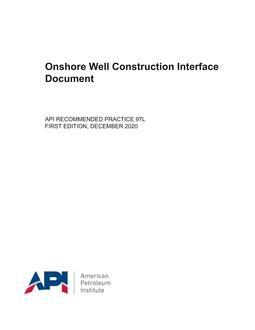No products
 View larger
View larger
API RP 97L
M00042110
New product
API RP 97L Onshore Well Construction Interface Document, First Edition
standard by American Petroleum Institute, 12/01/2020
Full Description
This document provides guidance on information that is to be shared regarding onshore well construction and rig-specific operating guidelines. It is intended to align the lease operator's and drilling contractor's safety andenvironmental management systems (SEMS).The purpose of the well construction interface document (WCID) is to enhance the health and safety of the workers and protect the environment by facilitating communication between the lease operator and drilling contractor regarding well construction work (drilling, suspension, completion, testing, and abandonment).
In stock
More info
Onshore Well Construction Interface Document
API RECOMMENDED PRACTICE 97L FIRST EDITION, DECEMBER 2020
Special Notes
API publications necessarily address problems of a general nature. With respect to particular circumstances, local, state, and federal laws and regulations should be reviewed. The use of API publications is voluntary. In some cases, third parties or authorities having jurisdiction may choose to incorporate API standards by reference and may mandate compliance.
Neither API nor any of API’s employees, subcontractors, consultants, committees, or other assignees make any warranty or representation, either express or implied, with respect to the accuracy, completeness, or usefulness of the information contained herein, or assume any liability or responsibility for any use, or the results of such use, of any information or process disclosed in this publication. Neither API nor any of API’s employees, subcontractors, consultants, or other assignees represent that use of this publication would not infringe upon privately owned rights.
API publications may be used by anyone desiring to do so. Every effort has been made by the Institute to ensure the accuracy and reliability of the data contained in them; however, the Institute makes no representation, warranty, or guarantee in connection with this publication and hereby expressly disclaims any liability or responsibility for loss or damage resulting from its use or for the violation of any authorities having jurisdiction with which this publication may conflict.
API publications are published to facilitate the broad availability of proven, sound engineering and operating practices. These publications are not intended to obviate the need for applying sound engineering judgment regarding when and where these publications should be used. The formulation and publication of API publications is not intended in any way to inhibit anyone from using any other practices.
Any manufacturer marking equipment or materials in conformance with the marking requirements of an API standard is solely responsible for complying with all the applicable requirements of that standard. API does not represent, warrant, or guarantee that such products do in fact conform to the applicable API standard.
Users of this Recommended Practice should not rely exclusively on the information contained in this document. Sound
business, scientific, engineering, and safety judgment should be used in employing the information contained herein.
All rights reserved. No part of this work may be reproduced, translated, stored in a retrieval system, or transmitted by any means, electronic, mechanical, photocopying, recording, or otherwise, without prior written permission from the publisher. Contact the Publisher, API Publishing Services, 200 Massachusetts Avenue, NW, Suite 1100, Washington, DC 20001-5571.
Copyright © 2020 American Petroleum Institute
ii
Foreword
Nothing contained in any API publication is to be construed as granting any right, by implication or otherwise, for the manufacture, sale, or use of any method, apparatus, or product covered by letters patent. Neither should anything contained in the publication be construed as insuring anyone against liability for infringement of letters patent.
The verbal forms used to express the provisions in this document are as follows.
Shall: As used in a standard, “shall” denotes a minimum requirement to conform to the standard.
Should: As used in a standard, “should” denotes a recommendation or that which is advised but not required to conform to the standard.
May: As used in a standard, “may” denotes a course of action permissible within the limits of a standard. Can: As used in a standard, “can” denotes a statement of possibility or capability.
ThisdocumentwasproducedunderAPIstandardizationproceduresthatensureappropriatenotificationandparticipation in the developmental process and is designated as an API standard. Questions concerning the interpretation of the content of this publication or comments and questions concerning the procedures under which this publication was developed should be directed in writing to the Director of Standards, American Petroleum Institute, 200 Massachusetts Avenue, NW, Suite 1100, Washington, DC 20001. Requests for permission to reproduce or translate all or any part of the material published herein should also be addressed to the director.
Generally, API standards are reviewed and revised, reaffirmed, or withdrawn at least every five years. A one-time extension of up to two years may be added to this review cycle. Status of the publication can be ascertained from the API Standards Department, telephone (202) 682-8000. A catalog of API publications and materials is published annually by API, 200 Massachusetts Avenue, NW, Suite 1100, Washington, DC 20001.
Suggested revisions are invited and should be submitted to the Standards Department, API, 200 Massachusetts Avenue, NW, Suite 1100, Washington, DC 20001, standards@api.org.
iii
Contents
Page
Scope 1
Normative References 2
Terms, Definitions, Acronyms, and Abbreviations 2
Terms and Definitions 2
Acronyms and Abbreviations 4
Drilling Contractor’s and Lease Operator’s SEMS Interface 5
General 5
Management Principles and Organizational Structures 5
Safety and Environmental Information 5
Hazards Analyses 6
Management of Change 6
Operating Procedures 7
Safe Work Practices 8
Training 8
Assurance of Quality and Integrity of Critical Equipment 8
Prestartup Review 8
Emergency Response 9
Investigation of Incidents 9
Audit of Safety and Environmental Management Program 9
Records and Documentation 9
Stop Work Authority 9
Well Plan Interface (WCID Plan) 10
General 10
Location and Operating Environment 10
Geologic and Geophysical 11
Well Design 11
Well Barriers 12
Well Plan 13
Well Activity Risk Management 13
WCID Acknowledgement 14
Bibliography 15
Figures
1 Well Construction Interface Document (WCID) Information 1
v

